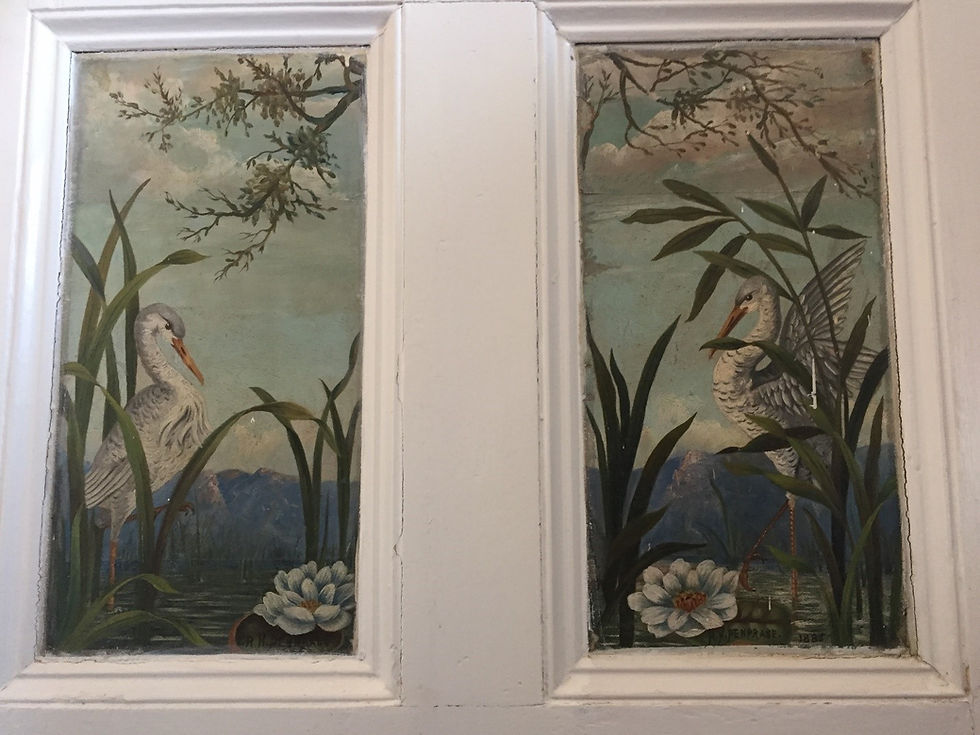Ghosts in the Machine
- colinfell6

- May 4, 2020
- 4 min read
Being confined to the house can do strange things to the mind, none stranger than to provoke the desire to do violently creative things to it- to strip wallpaper, varnish and paint, to expose ancient walls and timbers…I should admit that in me the fires of enthusiasm for any sort of practical work burn very low, but the flames are capable of being fanned into ravaging but short lived bush fires when the wind is in the wrong direction…
But what’s really interesting is what one discovers during these forays into the unfamiliar. My house was built in the 1850s, the terrace patriotically named after a recent military victory in the Crimea; an elderly, now deceased neighbour told me that there were originally iron gates at either end of the road, to prevent idlers. In the near two centuries since the clay-pipe smoking, whiskered builders began to haul granite into place on a patch of newly cleared heath, hundreds of souls have lived, fought, loved, worked and slept between the walls we now call our home. And it’s impossible to live in a house without leaving traces of your existence behind, the fingerprints visible to the forensic eye. It might be the blackened stones around what was the kitchen hearth, reminding us of the generations who clustered round it on long winter’s nights as the Cornish rain and wind lashed the rooves and rattled the sash windows. Perhaps the ancient cupboard door made from broad planks of elm, cut from great trees which would have waved and watched over 18th century wheat fields, and whose scalloped silhouette reveals it to have originally concealed an outdoor privy. Upstairs a secret window emerged defiantly from behind thick wallpaper and flaking plaster; it apparently connected two rooms, but what on earth for?
And then there’s the attic, which was torn apart during renovations this winter. On the door, in faint and almost imperceptible Victorian pencilled copperplate is the single word closet, suggesting that this room was to be thought of as a bedroom- remember Gertrude’s order to her awkward son Hamlet to come to her closet…running under the floorboards we found the wires which would have connected to bell pulls enabling a maid to be summoned; another body living and breathing here. And as the plaster fell from the wall under heavy pick axes, there was no sign of an old fire place- poor girl, sleeping up under the rafters, only some lath and plaster between her and the cold stars, waiting to be summoned by bells…
My brief dig into the census returns revealed that in 1891, crammed between the walls we call ours were a couple with three of their own children, and three belonging to the wife by a first marriage. As a Yorkshireman in exile, I was interested to note that the wife had also come down to Cornwall from that part of the world, presumably following the death of her husband. What a journey it would have been at that time! What led the young widow Martha Rawlings to go all the way to Cornwall with a man from Shropshire to start all over again? Such insoluble mysteries. Oh Martha, why? As if this wasn’t enough, residing as well, in two rooms of his own, was Henry Jennings, the vicar of St Johns’, the church which still looms over Eastern Penzance, its bulk a poignant metaphor for the might of 19th century Anglicanism. Cleaning up the old door which led to what were presumably his rooms, I was struck by the sheer amount of ironmongery which appeared to have been screwed to it at some stage- hooks, latches, locks… clearly the signs of someone who needed to isolate themselves within what would have been a busy house- writing the words to sermon that no-one would hear, perhaps, as teenagers and young children clattered overhead. Was Henry Jennings a friend of local artist R.H.Penprase, and does this explain the rather beautiful paintings of herons executed in 1885 and mysteriously attached to the door panels in what was probably his drawing room? We shall never know, but I’m glad they’re there, watching over me as I work. According to Google, Penprase, would have been twenty six years old, and was described in the census as an “employed decorative painter”, specialising in church decoration and restoration. Tantalisingly, the Cornish Archives holds a letter from a much older Henry Jennings to his successor at Millbrook, warning him about the vicarage ghost; was he troubled by such visitations when he lived here?
As we move through our brief tenancy, we leave our signs behind for others to decode. One day someone will puzzle over the blurry outlines on a bedroom door, unaware that they traced the outline of the large wooden comic letters spelling out the name of a child long since grown up; someone will speculate about who planted the old pear tree in the garden, and wonder how it acquired its peculiar slant, leaning ever closer to the ground as the years go by. As Le Corbusier said, the house is a machine, and we are all ghosts flitting silently through its corridors…





Comments